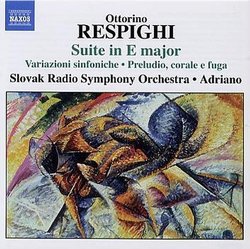| All Artists: Ottorino Respighi, Adriano, Slovak Radio Symphony Orchestra (Bratislava), Slovak Radio Symphony Orchestra Bratislava, Ferdinand Klinda Title: Respighi: Suite in E major Members Wishing: 0 Total Copies: 0 Label: Naxos Original Release Date: 1/1/2005 Re-Release Date: 10/18/2005 Genre: Classical Styles: Forms & Genres, Theatrical, Incidental & Program Music, Historical Periods, Modern, 20th, & 21st Century, Symphonies Number of Discs: 1 SwapaCD Credits: 1 UPC: 747313282029 |
Search - Ottorino Respighi, Adriano, Slovak Radio Symphony Orchestra (Bratislava) :: Respighi: Suite in E major
 | Ottorino Respighi, Adriano, Slovak Radio Symphony Orchestra (Bratislava) Respighi: Suite in E major Genre: Classical
|
Larger Image |
CD DetailsSimilar CDs
|
CD ReviewsEarly Respighi -- Wheat Amongst the Chaff J Scott Morrison | Middlebury VT, USA | 10/26/2005 (3 out of 5 stars) "These works are all early Respighi, some of them composed while he was still a student, and they are all more or less Romantic/Classical in form. 'Variazioni sinfoniche', composed while he was studying at the Bologna Conservatoire, consists of Brahmsian passacaglia-like variations and concludes in an awkward fugue. The work is a little unusual in that it includes an organ. 'Prelude, corale e fuga' (echoing Franck's work of the same name) is an 18 minute work played without pause and is similar in style to the Variations that precedes it on this disc. Respighi had gone to Russia in 1901 and probably finished it there, and it's even possible that Rimsky Korsakoff examined it. It, too, has more than its share of awkward writing, but it seems a bit of an advance on the Variations although it was written only a year later. 'Suite in E Major' is a symphony in all but name, with four movements. Although they do not appear on the score, the movements were tentatively called 'Nella foresta', 'Visione,' Danza,' and 'Eroica.' The Dance is particularly interesting for its tricky rhythms. The fourth movement is a bit overblown but exciting nonetheless. The Adagio (II) is a meltingly lovely cavatina arranged from a love duet in Respighi's withdrawn opera 'Semirana.' 'Burlesca,' written in 1906, shows a movement of Respighi's style from the classical/romantic to the proto-impressionistic. There is a good deal of modal harmony, familiar to all who know Respighi's later tone poems. 'Ouverture carnevalesca,' premièred in 1913, is, for me, the highlight of the disc. Since it is the latest work presented here, it may be that I'm simply more impressed with Respighi's later style. But I also think it is a superior work. Most of the hallmarks of Respighi's masterly orchestration are here. An altogether charming work. Adriano, the single-named Swiss conductor/composer, is a specialist in Respighi's music and has given us many recordings of his music; none of the music on this disc had been recorded prior to its original release in 1992 on Naxos's full-priced sister label, Marco Polo. Adriano's direction is expert and suave; unfortunately he is all too often let down by the tentative playing of the Slovak Radio Symphony Orchestra. But one can get plenty of indication of how the music would go in the hands of a better orchestra. I would suggest that both 'Burlesca' and 'Ouverture carnevalesca' would make wonderful openers for a symphony concert. Scott Morrison" THOROUGHLY ENJOYABLE E. Smith | Tucson, AZ | 10/23/2008 (5 out of 5 stars) "Each one of us have different DNA for how we hear music and judge it. There are pieces that some think are great with which I find disappointing. Yet, on the other hand, there are works that some consider mediocre and I have found them to be 5 stars every time I listen to them. To my ear the music on this CD deserves 5 stars. Or shall I say I "heard" 5 stars. I am at this very moment listening a third time to this music by Respighi. Each selection is absolutely enjoyable! The Suite in E major is extremely attractive. These selections would be considered mature works if a late 19th century Romantic composer had written them." The roots of Respighi... vmzfla | Orlando, Fl. | 03/19/2007 (3 out of 5 stars) "This mildly entertaining disc will interest those wanting a close look at Respighi's orchestral writing development. Swiss born Adriano(conductor)over the years has made a specialty of Respighi's music and he receives good orchestra support and at least fair sound engineering. The recording only lacking ripeness. The selections here, show how Respighi
was influenced by other romantic period composers. The 1900 "Symphonic Var." owe much to Franck and Brahms, exhibiting Respighi's early mastering of brass and the variation form. There is also a spot for organ; this being one of the more interesting selections. The "Preludio" of 1901, reminds us of Saint-Saens "Organ Sym." and it's conclusion references "Also Sprach Zarathustra". "Burlesca" of 1906 is the early impressionism form that would later sprout the "Fountains of Rome" masterpiece; both pictures of flowing and gushing waters. "Overture Carnevalesca" 1913, is his most Italian early work scored for a large orchestra. Respighi is in his most jovial mood but never over-blows the instrumentation. The "Suite in E major" is actually in symphonic form. It stems from 1901 but was probably revised and first performed in 1903. It contains some lovely themes from an opera that Respighi discarded and has a definite Russian influence, and even more from Dvorak. It's 4 movements are over 32min. in length and it's mood is optomistic. Overall this release will only really appeal to those totally consumed by the composer Respighi." |

 Track Listings (8) - Disc #1
Track Listings (8) - Disc #1